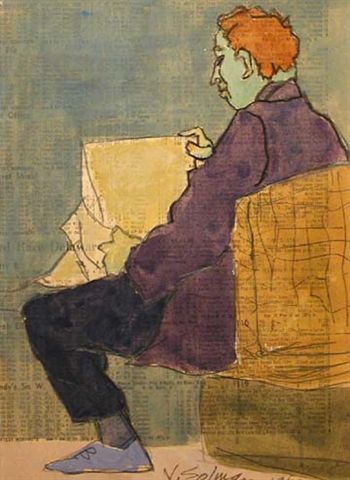Notes from the Underground,
Subway Portraits by Joseph Solman
March 14, 2007 — May 20, 2007
Opening Reception Saturday, March 17, 6 – 8 p.m.
Lunchtime Gallery Talk with curator Lisa Leavitt, Wednesday, April 25, noon
Conversation with Paul Solman (son of the artist) and curator Lisa Leavitt, Saturday, May 5, 3 p.m.
“Painter Joseph Solman: Taking bets on real life” The Framingham Tab, May 4, 2007
Joseph Solman was, with Mark Rothko, a co-founder of The Ten, a group of expressionist painters who worked in New York City in the 1930s. A devout modernist during a time when social realism was in favor, Solman infused his New York street scenes with abstract qualities yet never abandoned recognizable subject matter. Solman, the only survivor of The Ten, now in his late nineties, has not received appropriate recognition for his “poetic paintings…(which) force the spectator to discover strange beauties in unpromising places.” (The New York Times, 1940).
Since his late teens, Solman sketched quick studies of people, shops and signage on the streets and alleyways of Jamaica, Long Island, where he lived with his family. In the 1930s, he began to document the streets of New York City and became quite well known as a founding member of The Ten in 1935. Solman, inspired by the Second Armory Show, which showcased the achievements of such modern artists as Picasso and Braque, incorporated elements of Cubism into his urban scenes, interiors and portraiture. Solman’s work is included in the collections of the Whitney Museum of Art, New York; Hirshhorn Museum and Sculpture Garden, Smithsonian Institute, Washington D.C.; Museum of Fine Arts, Boston; Boston Public Library; and the Rose Art Museum, Brandeis University, among many others.
About the Exhibition
Claiming “the subway was his art school,” 98 year-old New York painter, Joseph Solman, documented dozens of passengers as he commuted to work as a part-time bookie at the Belmont Park race track in Long Island, NY, in the 1960s. With pencil in hand and the daily racing forms as his paper, Solman used sparing, gestural lines to record random travelers engrossed in their private worlds amidst the public space of the commuter train.
Curator Lisa Leavitt has organized this exhibition with the intention to give greater exposure to an often overlooked artist much loved by Bostonians as evidenced by the lenders to this intimate exhibition. “Solman carries on the distinctly American tradition of documenting the urban landscape that began with the Ashcan School at the beginning of the Twentieth Century, continued with Reginald Marsh, sculptor George Segal, and persists today as seen by Cindy Sherman’s recently exhibited Straphangers show at Barbara Krakow Gallery. Solman’s subway paintings eloquently capture the tenor of the commuter train, which can be a metaphor for urban America: both crowded and noisy, yet ironically isolated and self-contained.”

Joseph Solman, Red Hair, 1960
Gouache on newspaper, 10″ x 7 3/8″
Courtesy of Mercury Gallery, Boston
